
Ballet is a type of performance dance that originated during the Italian Renaissance in the fifteenth century and later developed into a concert dance form in France and Russia. It has since become a widespread and highly technical form of dance with its own vocabulary. Ballet has been influential globally and has defined the foundational techniques which are used in many other dance genres and cultures. Various schools around the world have incorporated their own cultures. As a result, ballet has evolved in distinct ways.

The intermedio, in the Italian Renaissance, was a theatrical performance or spectacle with music and often dance, which was performed between the acts of a play to celebrate special occasions in Italian courts. It was one of the important precursors to opera, and an influence on other forms like the English court masque. Weddings in ruling families and similar state occasions were the usual occasion for the most lavish intermedi, in cities such as Florence and Ferrara. Some of the best documentation of intermedi comes from weddings of the House of Medici, in particular the 1589 Medici wedding, which featured what was undoubtedly both the most spectacular set of intermedi, and the best known, thanks to no fewer than 18 contemporary published festival books and sets of prints that were financed by the Grand Duke.
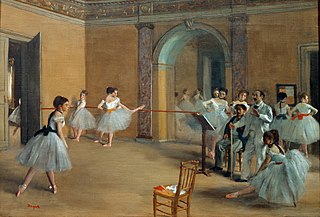
Classical ballet is any of the traditional, formal styles of ballet that exclusively employ classical ballet technique. It is known for its aesthetics and rigorous technique, its flowing, precise movements, and its ethereal qualities.
In the French courts during the 17th Century, ballet first begins to flourish with the help of several important men: King Louis XIV, Jean-Baptiste Lully, Pierre Beauchamps, and Molière. The combination of different talents and passions of these four men shaped ballet to what it is today.
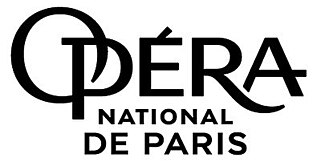
The Paris Opera is the primary opera and ballet company of France. It was founded in 1669 by Louis XIV as the Académie d'Opéra, and shortly thereafter was placed under the leadership of Jean-Baptiste Lully and officially renamed the Académie Royale de Musique, but continued to be known more simply as the Opéra. Classical ballet as it is known today arose within the Paris Opera as the Paris Opera Ballet and has remained an integral and important part of the company. Currently called the Opéra national de Paris, it mainly produces operas at its modern 2,723-seat theatre Opéra Bastille which opened in 1989, and ballets and some classical operas at the older 1,979-seat Palais Garnier which opened in 1875. Small scale and contemporary works are also staged in the 500-seat Amphitheatre under the Opéra Bastille.
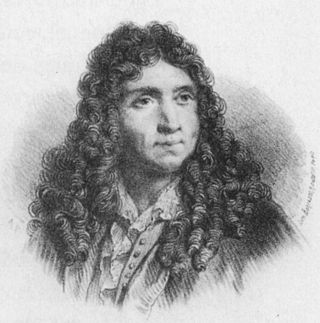
Pierre Beauchamp or Beauchamps was a French choreographer, dancer and composer, and the probable inventor of Beauchamp–Feuillet notation. His grand-father was called Christophe and his father, a violinist of the king's chamber, was simply called Louis. Following a custom of the time, Pierre Beauchamp was named Pierre after his godfather Pierre Vacherot, tailor of the queen's pages and a relative of the Beauchamps family.

The Ballet Comique de la Reine was an elaborate court spectacle performed on October 15, 1581, during the reign of Henry III of France, in the large hall of the Hôtel de Bourbon, adjacent to the Louvre Palace in Paris. It is often referred to as the first ballet de cour.

Balthasar de Beaujoyeulx, originally Baldassare daBelgiojoso was an Italian violinist, composer, and choreographer.
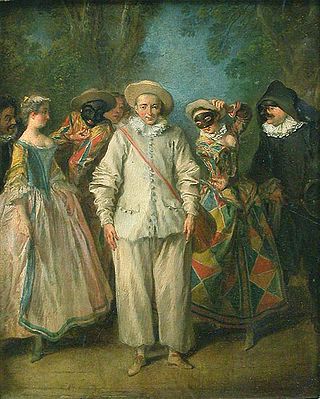
Comédie-Italienne or Théâtre-Italien are French names which have been used to refer to Italian-language theatre and opera when performed in France.
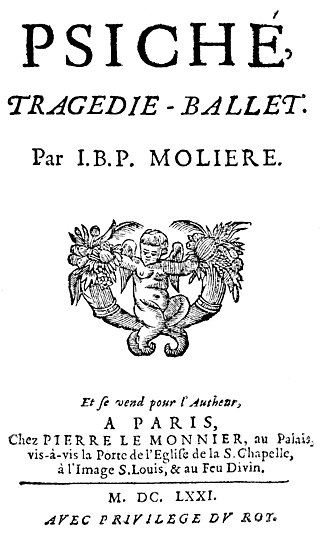
Psyché is a five-act tragédie-ballet, originally written as a prose text by Molière and versified in collaboration with Pierre Corneille and Philippe Quinault, with music composed by Jean-Baptiste Lully in 1671 and by Marc-Antoine Charpentier in 1684. The plot is based on the story of Cupid and Psyche in The Golden Ass, written in the 2nd century by Apuleius. It was first performed on 17 January 1671 before the royal court of Louis XIV at the Théâtre des Tuileries, with ballets by Pierre Beauchamps, Anthoine des Brosses, and Nicolas Delorge, and spectacular scenery and special effects designed by Carlo Vigarani.

Ballet is a formalized dance form with its origins in the Italian Renaissance courts of 15th and 16th centuries. Ballet spread from Italy to France with the help of Catherine de' Medici, where ballet developed even further under her aristocratic influence. An early example of Catherine's development of ballet is through 'Le Paradis d' Amour', a piece of work presented at the wedding of her daughter Marguerite de Valois to Henry of Navarre. Aristocratic money was responsible for the initial stages of development in 'court ballet', as it was royal money that dictated the ideas, literature and music used in ballets that were created to primarily entertain the aristocrats of the time. The first formal 'court ballet' ever recognized was staged in 1573, 'Ballet des Polonais'. In true form of royal entertainment, 'Ballet des Polonais' was commissioned by Catherine de' Medici to honor the Polish ambassadors who were visiting Paris upon the accession of Henry of Anjou to the throne of Poland. In 1581, Catherine de' Medici commissioned another court ballet, Ballet Comique de la Reine, however it was her compatriot, Balthasar de Beaujoyeulx, who organized the ballet. Catherine de' Medici and Balthasar de Beaujoyeulx were responsible for presenting the first court ballet ever to apply the principles of Baif's Academie, by integrating poetry, dance, music and set design to convey a unified dramatic storyline. Moreover, the early organization and development of 'court ballet' was funded by, influenced by and produced by the aristocrats of the time, fulfilling both their personal entertainment and political propaganda needs.

A series of lavish and spectacular court entertainments, sometimes called magnificences, were laid on by Catherine de' Medici, the queen consort of France from 1547 to 1559 and queen mother from 1559 until her death in 1589. As wife of Henry II of France, Catherine showed interest in the arts and theatre, but it was not until she attained real political and financial power as queen mother that she began the series of tournaments and entertainments that dazzled her contemporaries and continue to fascinate scholars. Biographer Leonie Frieda suggests that "Catherine, more than anyone, inaugurated the fantastic entertainments for which later French monarchs also became renowned".

Catherine de' Medici was a patron of the arts made a significant contribution to the French Renaissance. Catherine was inspired by the example of her father-in-law, King Francis I of France, who had hosted the leading artists of Europe at his court. As a young woman, she witnessed at first hand the artistic flowering stimulated by his patronage. As governor and regent of France, Catherine set out to imitate Francis's politics of magnificence. In an age of civil war and declining respect for the monarchy, she sought to bolster royal prestige through lavish cultural display.

Italian ballet is the training methods and aesthetic qualities seen in classical ballet in Italy. Ballet has a long history in Italy, and it is widely believed that the earliest predecessor of modern-day ballet originated in the Italian courts of the Renaissance. Two predominant training systems are used to teach Italian ballet today: the Cecchetti method, devised by Enrico Cecchetti, and that of the La Scala Theatre Ballet School.
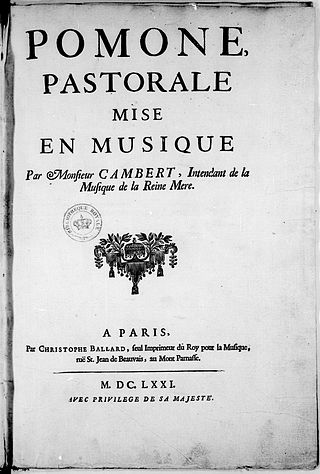
Pomone (Pomona) is a pastoral opera in a prologue and five acts by Robert Cambert with a libretto by Pierre Perrin. It has been described as "effectively the first French opera." It was first performed in Paris at the Jeu de Paume de la Bouteille theatre belonging to Cambert and Perrin's Académie d'Opéra on 3 March 1671. The production had ballets choreographed by Des Brosses and sets and machinery designed by Alexandre de Rieux, marquis de Sourdéac. The novelty of the work drew large audiences and the opera enjoyed 146 performances over the eight months of its run. The score of Pomone has only partially survived.

The Hôtel du Petit-Bourbon, a former Parisian town house of the royal family of Bourbon, was located on the right bank of the Seine on the rue d'Autriche, between the Louvre to the west and the Church of Saint-Germain l'Auxerrois to the east. It was constructed in the 14th century, not long after the Capetian Kings of France enlarged the fortress of the Louvre in order to use it as a royal residence. On two 1550 maps it is shown simply as the Hôtel de Bourbon, but by 1652, as the Petit-Bourbon on the map of Gomboust. The Bourbons took control of France in 1589, at which time they also acquired the Louvre.

Girard de Beaulieu, better known by the incorrectly recorded name Lambert de Beaulieu was a French bass singer, instrumentalist, and composer. He was employed at the court of Henri III as basse singer and composer from 1559. He was associated with the Académie de Baïf, one of whose aristocratic poets, Nicolas Filleul de La Chesnaye, the king's almoner, was to provide the lyrics for the ballet Circé in the first French ballet de cour, the Balet Comique de la Royne of 1581, for which Beaulieu and Jacques Salmon provided the music. Choreography and overall direction were provided by the Italian dancing master Baltazarini, known as Balthasar de Beaujoyeulx. Sets and costumes were provided by Jacques Patin.

Violante Doria, also known as Yolande or Yolante, was an Italian soprano from Genoa. She was considered to be one of “the most successful musicians in France during the reigns of the last Valois kings.” She was married to bass singer Girard de Beaulieu who was a well-known and important singer of the royal court from as early as 1572 until the last year of his life in 1590.” The couple played a large role in the creation of the French ballet de cour, the Balet comique de la royne, in 1581. The successful careers of both Doria and her husband were an important part of structuring the music of the royal court and show the significance in the rise of chamber music.

The important place of women in dance can be traced back to the origins of civilization. Cave paintings, Egyptian frescos, Indian statuettes, ancient Greek and Roman art and records of court traditions in China and Japan all testify to the important role women played in ritual and religious dancing from the start. In the Middle Ages, what has become known as ballet had its beginnings in Italian court festivals when women frequently played the parts of men. It was however in late 17th-century France that the Paris Opera produced the first celebrated ballerinas. While women began to dominate the ballet scene in the 18th century, it was with the advent of Romantic ballet in the 19th century that they became the undisputed centre of attraction with stars playing the leading roles in the works of Marius Petipa, appearing in theatres across Europe from Milan's La Scala to the Mariinsky Theatre in Saint Petersburg. More recently, women have played a leading role in developing various forms of modern dance including flamenco and expressionist dance.



















